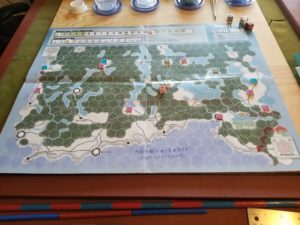My first try at Finnish Civil War ended a Red marginal victory. Nothing went right for the Whites. Random events were usually bad, and they never made the necessary progress on the Peace Negotiations track. This progress leads to a withdrawl of Soviet forces and German intervention. The Finns needed both because the Red Guard units just keep coming and coming in the reinforcement phase and the Soviets have mobility, and the ability to coordinate multi-hex attacks.
Planned on writing a summary of the last three Brian Train designs played, but FCW is just too different to lump in with Freikorps and Konarmiya. So that will wait.
One reason is scale. Nothing but ants. And, that’s OK. But, restrictive terrain, and the requirement for all units to perform the same action in each segment, leads to an entirely different operational mindset. Oh, and did I mention the need to make bloody low-odds attacks? If you wait for a juicy 3:1 or 4:1, you will just have to wait and wait. And if you don’t get that progress on the Peace Negotiations track?
Higher odds attacks take time to develop. Both Red and White Guard units cannot move through woods until after the Spring Thaw. They are restricted to clear hexes and rail lines. Any envelopments, which also require an adjacent headquarters , can only be conducted with Finnish National Army (FNA) or Soviet units. At best, these envelopments are local because axes of advance are channelized by forests.
The great force multiplier is artillery (or armored trains if using optional rules). Each artillery counter adds/subtracts one from the die roll (as appropriate). There is no restriction to the number of artillery units that can be brought into play as reinforcements. Each unit with an attack factor can have an accompaning artillery counter.
Good game. Plan on playing this again after TAD.
